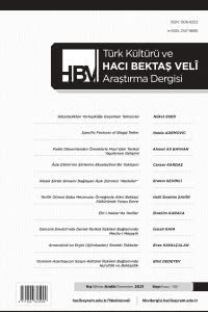Hoca Ahmet Yesevi'nin toponimik mirası
Toponymic heritage, Toponym, Nekronym, Hydronym, Econym, Intensive toponymy
KHWAJA AHMAD YASAWI’S TOPONYMIC HERITAGE
___
- Baqyrgani Suleymen. (2008). Aqyrzaman [Apocalypse](Qorabay S., Ed.; Vol 7). “Taimas” baspa uii.
- Bell, H. (2018). Exploring Nubian Toponymy in its Traditional Environment. In Nubian Archaeology in the XXIst Century. Proceedings of the Thirteenth International Conference for Nubian Studies, Neuchâtel. Leuven.
- Blair, D., & Tent, J. (2021). A Revised Typology of Place-Naming. Names, 69(4), 30-47.
- Coates, R. (2020). The island name KRK, Croatia, in its mediterranean and European context. Voprosy Onomastiki, 17(3), 186–208. https://doi.org/10.15826/vopr_onom.2020.17.3.039
- Creswell, J. W., & Creswell, J. D. (2018). Research design: Qualitative, quantitative, and mixed methods approaches.
- Crljenko, I. (2017). Classification method in exonym studies. Hrvatski geografski glasnik, 79(1), 81-106.
- Crljenko, I. (2020). Geographical names as a research topic for Croatian geographers. Hrvatski geografski glasnik, 82(1), 59-83.
- Dey, I. (2005). Qualitative data analysis: A user-friendly guide for social scientists.
- Everett-Heath, J. (2000). Place names of the world-Europe: historical context, meanings and changes. Springer.
- Flick, J. U. (2014). The Sage handbook of qualitative data analysis. Los Angeles: Sage.
- Fraser, P. M. (1996). Cities of Alexander the Great. Clarendon Press.
- Given, L. M. (Ed.). (2008). The Sage encyclopedia of qualitative research methods. Sage publications.
- Green, P. (2013). Alexander of Macedon, 356–323 BC: a historical biography (Vol. 11). Univ of California Press.
- Gürer, B. (2017). Ahmed Yesevî’nin Dîvân-ı Hikmet’i Ekseninde Tasavvufi Düşüncede İlahi Aşk [The divine love in sufi thought within the framework of ahmad yasawi’s divan-e hikma]. Bilig, (80), 15-41.
- Hasan, N. (2012). Batı’da Yesevilik Çalışmaları [Yassawi studies in West]. Türk Kültürü ve Hacı Bektaş Veli Araştırma Dergisi, (61).
- Hough, C., & Izdebska, D. (Eds.). (2016). The Oxford handbook of names and naming. Oxford University Press.
- Kamalova Feride Bolatqyzy. (2020). Kazakhstannyng kieli zherleri: dintanuliq taldau [The sacral places of Kazakhstan: religious analysis] (Doctoral dissertation). Al-Farabi Kazakh National University, Almaty.
- KENZHETAYEV, D., & Muzaffer, TAN. (2020). Yassawi Culture Versus Historical Marxist Dialectic. Türk Kültürü ve Hacı Bektaş Velî Araştırma Dergisi, (95), 335-347.
- Kenzhetayev D.T., Zhandarbek Z.Z. (2017). Khozha Akhmet Yassawi. “Izdatelstvo Zolotaya kniga”
- Kladnik, D., Geršič, M., & Perko, D. (2020). Slovenian geographical names. Acta geographica Slovenica, 60(3), 7-190.
- Kovács, É. (2019). Toponymic findings in latin-language medieval hungarian charters: Classification, structural and motivational features. Voprosy Onomastiki, 16(4), 123–133. https://doi.org/10.15826/vopr_onom.2019.16.4.048
- Morkot, R., Baker, J., Orme, R., Fairbrass, A., Cox, J., & Haslam, B. (1996). The penguin historical atlas of ancient Greece. Penguin Books.
- Qorganbekov Bolatbek. (2011). Khozha Akhmet Yassawi esimimen bailanisti angyz, apsana, hikaialar [Legends and stories related with the name of Khozha Akhmet Yassawi] (2nd ed.). “Effekt.”
- Rácz, A., & Tóth, V. (2019). Settlement names derived from ethnonyms as historical evidence: The case of medieval Hungary. Voprosy Onomastiki, 16(1). https://doi.org/10.15826/vopr_onom.2019.16.1.006
- Randall, R. R. (2001). Place Names: How They Define the World--and More. Scarecrow Press.
- Richards, J. C., & Schmidt, R. (2010). Longman dictionary of language teaching and applied linguistics. Harlow: Longman.
- Skelton, D., & Dell, P. (2005). Empire of Alexander the Great. New York: Facts On File.
- Stewart, G. R. (1954). A classification of place names. Names, 2(1), 1-13.
- Tent, J. (2006). Geographic and Linguistic Reflections on Moent and Dubbelde Ree: Two of Australia's First Recorded Placenames. Geographical Research, 44(4), 372-385.
- Tent, J., & Slatyer, H. (2009). Naming places on the ‘Southland’: European place-naming practices from 1606 to 1803. Australian Historical Studies, 40(1), 5-31.
- Tent, J., & Blair, D. (2011). Motivations for naming: The development of a toponymic typology for Australian placenames. Names, 59(2), 67-89.
- Tent, J. (2015). Approaches to research in toponymy. Names, 63(2), 65-74.
- TÜRKÜRESİN, H. E. (2021). Pir-i Türkistan Hoca Ahmed Yesevî ve Divan-I Hikmet’te Bulunan Değerler [Pir-i Turkistan Hodja Aḥmad al-Yasawī and Values in Dīvān-ı Hikmat]. Türk Kültürü ve Hacı Bektaş Velî Araştırma Dergisi, (99), 267-284.
- Voronina, L. V., Melnikova, Y. N., & Skokova, T. N. (2019). Word-formation patterns in german toponymy: A dynamic perspective. Voprosy Onomastiki, 16(3), 78–90. https://doi.org/10.15826/vopr_onom.2019.16.3.032
- Yassawi Akhmet. (1993). Diwani hikmet (Aqyl kitabi) [Divine Wisdom] (Zharmuhameduly M., Ed.). “Murattas” ortalygy.
- Zhandarbek, Z. (2006). Yassawi zholy zhane qazaq qogamy [Yassawi’s path and Kazakh society]. “El-shezire.”
- ISSN: 1306-8253
- Yayın Aralığı: 4
- Başlangıç: 1994
- Yayıncı: Ankara Hacı Bayram Veli Üniversitesi Türk Kültürü Açısından Hacı Bektaş-ı Veli Araştırmaları Uygulama ve Araştırma Merkezi
SEZAİ KARAKOÇ’UN ÇOCUKLUĞUMUZ ŞİİRİNDE CENKNAMELERİN İZLERİ
Gökhan GÖKÇEK, Esin HÜDAVERDİ, Nebahat SÜLÇEVSİ
ALİ İLAHİ DEĞİL EHL-İ HAK’IZ; EHL-İ HAK TÜRKLERİNDE ALİ KÜLTÜ
Hoca Ahmet Yesevi'nin toponimik mirası
HORASAN’DA SERBEDARLAR HAREKETİ
MEVLÂNÂ’NIN ŞİİRLERİNDE REVÂKIYYE DÜŞÜNCESİNİN YANSIMALARI
Davoud SPARHAM, Mehmet ŞAHİN, Musa RAHİMİ
ALEVİLİK-BEKTAŞİLİK İLİŞKİSİ VE ALEVİLİĞİN BEKTAŞİLİKLE KAYNAŞMASI
